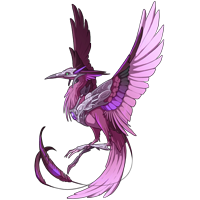

Aurora
(#71474467)
Pride comes before a fall. (G2 Imp)
Click or tap to view this dragon in Predict Morphology.
Energy: 50/50

Expand the dragon details section.
Collapse the dragon details section.
Personal Style
Apparel






Skin

Scene

Measurements
Length
28.37 m
Wingspan
15.87 m
Weight
8936.18 kg
Genetics
Platinum
Flaunt
Flaunt
Dust
Constellation
Constellation
Orchid
Opal
Opal
Hatchday
Breed
Eye Type
Level 1 Imperial
EXP: 0 / 245


STR
6
AGI
6
DEF
6
QCK
5
INT
8
VIT
8
MND
6
Biography
Bought from Innocenzia for around 600g (and some Snaggy cookies). 3rd G2 Imp get! Very pretty one too, from dragons #40 and #41. I'll keep her gene'd as is I think cos she's kinda nice with all the pink c: Named after the natural phenomena of polar lights seen predominantly in high latitude regions of Earth.
In terms of narrative, I was inspired to give her a theme from Starset's latest album 'Horizons'. I envision her as somewhat of a cautionary tale: a fall from grace due to over-ambition. She was once Apprenticed to those who control the shifting skies above our world, an honour most distinguished. Beloved by many for her mastery of the magnetosphere, she was poise and elegance incarnate. It would not be long until she mastered Sunlight itself...or so she thought.
She was warned but she did not listen. Her underlying self-destructive tendencies proved it was not to be. In her hubris, she blamed those around her for her misfortune despite being the cause of it herself. All she has left of her former prowess is her broken body. Pink opalescent shards breach the cracks in her skin, scorched by an unforgiving star. A Hollow reminder of the glorious past.
She was warned but she did not listen. Her underlying self-destructive tendencies proved it was not to be. In her hubris, she blamed those around her for her misfortune despite being the cause of it herself. All she has left of her former prowess is her broken body. Pink opalescent shards breach the cracks in her skin, scorched by an unforgiving star. A Hollow reminder of the glorious past.
~*~
- Yellow and pink are a mix of red and green or blue. Other shades of red, as well as orange, may be seen on rare occasions; yellow-green is moderately common. As red, green, and blue are linearly independent colors, additive synthesis could, in theory, produce most human-perceived colours, but the ones mentioned in this article comprise a virtually exhaustive list.
|
|
But they told him, "Beware
Do not fly too close to the sun" The blaze will surly melt their wings But alas, he fell His cries swallowed by the sea... |
|
~*~
  
|
An aurora (plural: auroras or aurorae), also known as the polar lights or aurora polaris, is a natural light display in Earth's sky, predominantly seen in high-latitude regions (around the Arctic and Antarctic). Auroras display dynamic patterns of brilliant lights that appear as curtains, rays, spirals, or dynamic flickers covering the entire sky. Auroras are the result of disturbances in the magnetosphere caused by solar wind. These disturbances alter the trajectories of charged particles in the magnetospheric plasma. These particles, mainly electrons and protons, precipitate into the upper atmosphere (thermosphere/exosphere). The resulting ionization and excitation of atmospheric constituents emit light of varying colour and complexity. The form of the aurora, occurring within bands around both polar regions, is also dependent on the amount of acceleration imparted to the precipitating particles. Most of the planets in the Solar System, some natural satellites, brown dwarfs, and even comets also host auroras. The word "aurora" is derived from the name of the Roman goddess of the dawn, Aurora, who travelled from east to west announcing the coming of the sun. Ancient Greek poets used the name metaphorically to refer to dawn, often mentioning its play of colors across the otherwise dark sky (e.g., "rosy-fingered dawn"). The word "borealis" is derived from the name of the Ancient Greek god of the north wind, Boreas, while the word "australis" is derived from the Latin auster (“south”). COLOURS: - Red: At its highest altitudes, excited atomic oxygen emits at 630 nm (red); low concentration of atoms and lower sensitivity of eyes at this wavelength make this colour visible only under more intense solar activity. The low number of oxygen atoms and their gradually diminishing concentration is responsible for the faint appearance of the top parts of the "curtains". Scarlet, crimson, and carmine are the most often-seen hues of red for the auroras. - Green: At lower altitudes, the more frequent collisions suppress the 630 nm (red) mode: rather the 557.7 nm emission (green) dominates. A fairly high concentration of atomic oxygen and higher eye sensitivity in green make green auroras the most common. The excited molecular nitrogen (atomic nitrogen being rare due to the high stability of the N2 molecule) plays a role here, as it can transfer energy by collision to an oxygen atom, which then radiates it away at the green wavelength. (Red and green can also mix together to produce pink or yellow hues.) The rapid decrease of concentration of atomic oxygen below about 100 km is responsible for the abrupt-looking end of the lower edges of the curtains. Both the 557.7 and 630.0 nm wavelengths correspond to forbidden transitions of atomic oxygen, a slow mechanism responsible for the graduality (0.7 s and 107 s respectively) of flaring and fading. - Blue: At yet lower altitudes, atomic oxygen is uncommon, and molecular nitrogen and ionized molecular nitrogen take over in producing visible light emission, radiating at a large number of wavelengths in both red and blue parts of the spectrum, with 428 nm (blue) being dominant. Blue and purple emissions, typically at the lower edges of the "curtains", show up at the highest levels of solar activity. The molecular nitrogen transitions are much faster than the atomic oxygen ones. - Ultraviolet: Ultraviolet radiation from auroras (within the optical window but not visible to virtually all humans) has been observed with the requisite equipment. Ultraviolet auroras have also been seen on Mars, Jupiter and Saturn. - Infrared: Infrared radiation, in wavelengths that are within the optical window, is also part of many auroras. |
(This and more from Wikipedia)
Click or tap a food type to individually feed this dragon only. The other dragons in your lair will not have their energy replenished.
Feed this dragon Insects.
Feed this dragon Meat.
Feed this dragon Seafood.
Feed this dragon Plants.
Exalting Aurora to the service of the Gladekeeper will remove them from your lair forever. They will leave behind a small sum of riches that they have accumulated. This action is irreversible.
Do you wish to continue?
- Names must be longer than 2 characters.
- Names must be no longer than 16 characters.
- Names can only contain letters.
- Names must be no longer than 16 characters.
- Names can only contain letters.

















